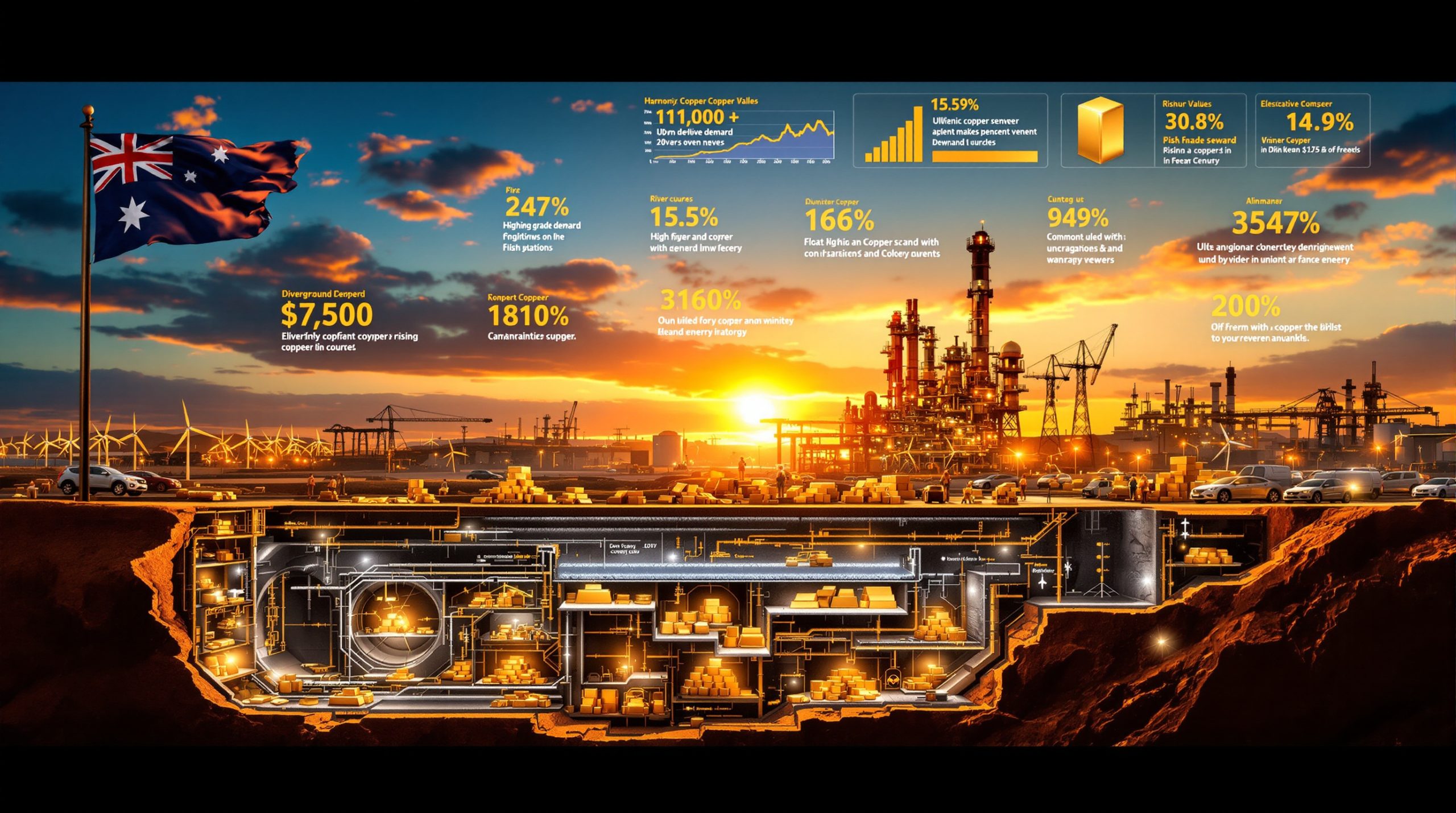How Are Gold and Iron Ore Exports Shaping Australia's Economy?
Australia's resource sector continues to demonstrate remarkable resilience despite global economic uncertainties, with gold and iron ore emerging as twin pillars supporting national export growth. Recent data reveals significant shifts in export patterns that are reshaping Australia's economic landscape and providing stability amid fluctuating global markets.
According to the September 2025 edition of Resources and Energy Quarterly, total resources and energy export earnings are forecast to reach $369 billion in 2025-26, representing a decrease from the estimated $385 billion in 2024-25. This decline is primarily attributed to growing global trade impacts affecting economic growth, with projections indicating a further reduction to $354 billion in 2026-27.
Despite these challenges, Australia's resource sector remains fundamentally strong. The increasing export volumes across key commodities demonstrate the sector's operational resilience, even as commodity price fluctuations create headwinds for overall earnings.
Current Export Performance and Projections
The resources and energy sector continues to be the backbone of Australia's export economy, representing approximately 65-70% of the country's total goods exports. This dominance underscores the critical importance of the sector to Australia's economic stability and growth prospects.
The production increases across several key commodities highlight Australia's continued competitiveness in global resource markets, even as commodity prices moderate from recent highs. Western Australia remains the epicenter of this export activity, accounting for approximately 50% of the nation's total mineral and energy resource value.
Why Is Gold Becoming Australia's Export Star?
Gold has emerged as the standout performer in Australia's export portfolio, experiencing unprecedented growth in both price and production volume. This precious metal is increasingly cementing its position as a cornerstone of Australia's export strategy.
Record-Breaking Gold Performance
Record-high gold prices have reached historic heights, exceeding US$3,600 per ounce in September 2025. This remarkable price performance has dramatically boosted the sector's export value, with gold export earnings forecast to reach $60 billion in 2025-26—representing a substantial 27.7% increase from $47 billion in 2024-25.
The sector is projected to maintain this strength with export earnings of approximately $59 billion in 2026-27, even as prices are expected to moderate slightly. This continued strong performance reflects both favorable market conditions and Australia's expanding production capacity.
Australia's gold production, ranging between 310-369 tonnes annually, has firmly established the country as the world's second-largest gold producer after China. Western Australia dominates this production landscape, accounting for approximately 70% of national output, with major producing regions including the historic Kalgoorlie-Boulder area and the resource-rich Pilbara.
Factors Driving Gold's Strong Performance
Several interconnected factors are powering gold's exceptional export performance:
Global economic uncertainty has significantly increased safe-haven investment demand, with investors seeking gold as a store of value during periods of inflation concerns and geopolitical tensions.
Central bank purchasing activity has resumed after a brief pause, adding substantial demand pressure. This institutional buying represents a fundamental shift in central bank reserve strategies, with many nations diversifying away from traditional currency holdings.
Australian miners have strategically expanded production capacity at key operations, leveraging favorable price conditions to increase output while maintaining disciplined cost control.
Technical innovations across the gold mining sector have markedly improved recovery rates and operational efficiency. Advanced ore sorting technologies, autonomous haulage systems, and real-time data analytics for processing optimization have collectively enhanced productivity.
The industry's major players, including Newmont Corporation (which acquired Newcrest Mining), Northern Star Resources, and Evolution Mining, have implemented sophisticated operational strategies that combine resource expansion, technological innovation, and cost optimization.
How Does Iron Ore Maintain Its Export Leadership?
Despite price moderation, iron ore continues to dominate Australia's export landscape through volume growth and strategic market positioning. As Australia's leading resource export by value, iron ore accounts for approximately 25% of all resource and energy export earnings.
Iron Ore Export Dominance
The sector's resilience is evident in its export volumes, with July 2025 shipments reaching 75 million tonnes—a 5% year-over-year increase. This volume growth has helped maintain iron ore's position as Australia's most valuable resource export, with annual values exceeding $85 billion.
Australia's iron ore industry is characterized by world-class operations primarily concentrated in Western Australia's Pilbara region. The sector's major players—BHP, Rio Tinto, and Fortescue Metals Group—collectively produce over 800 million tonnes annually, operating some of the world's largest and most efficient mining operations.
Strategic Advantages in Iron Ore Exports
Australia's iron ore export success stems from several interconnected competitive advantages:
Geographic proximity to Asian markets, particularly China, provides a 7-14 day shipping advantage over competitors such as Brazil. This proximity translates into lower freight costs and more responsive supply chains.
China remains the dominant destination market, accounting for over 80% of Australia's iron ore exports. This concentration reflects China's position as the world's largest steel producer, manufacturing approximately 1.02 billion tonnes of crude steel annually.
Superior logistics infrastructure significantly enhances Australia's export efficiency. Port Hedland—the world's largest bulk export port by tonnage—along with Dampier and Cape Lambert, provide unparalleled shipping capacity and operational reliability.
Australian iron ore typically features high iron content (62-65% Fe) compared to competing nations, with Pilbara ore particularly valued for its quality and low impurity levels. This quality premium translates into pricing advantages and preferred buyer status.
What's Happening with Other Resource Exports?
While gold and iron ore lead Australia's resource export portfolio, other commodities are experiencing varied performance in the current market environment. This diversity highlights both challenges and opportunities across the broader resources sector.
Mixed Performance Across the Resource Sector
LNG export earnings have been weaker than initially expected, creating a drag on overall resource export values. This underperformance contrasts with LNG's 2022-23 position as Australia's second-largest resource export, when it generated approximately $91.5 billion in export revenue.
Copper maintains strong demand fundamentals, supported by the global electrification trend. Copper's essential role in renewable energy infrastructure (requiring 3-4 times more copper than fossil fuel systems) and electric vehicle production (EVs use 2-4 times more copper than conventional vehicles) underpins its positive outlook.
Critical minerals, particularly lithium, continue to attract market interest despite price volatility. Australia holds a commanding position as the world's largest lithium producer, accounting for approximately 47% of global mine production. The Australian Government's "Critical Minerals Strategy 2023-2030" identifies 31 critical minerals essential for manufacturing and the energy transition.
Coal exports face long-term structural challenges as global energy systems evolve. While Australia exported approximately 372 million tonnes of coal in 2022-23 (metallurgical and thermal combined), the long-term demand trajectory remains uncertain amid global decarbonization efforts.
Capital Investment Trends
The resources sector continues to attract substantial capital investment, with companies focusing on:
Productivity improvements and operational efficiency enhancements to maintain competitiveness in moderating price environments.
Advanced technology adoption, including automation, artificial intelligence, and data analytics to optimize operations and reduce costs.
Processing capacity development and value-adding capabilities to capture additional margin from resource extraction.
Exploration activities that, while softening somewhat, remain at historically robust levels as companies seek to replenish reserves and identify new growth opportunities.
How Are Global Market Conditions Affecting Australia's Export Outlook?
International trade dynamics and economic conditions are creating both challenges and opportunities for Australian resource exporters. These global factors are increasingly influential in determining Australia's export trajectory.
Global Market Influences
Growing trade barriers are increasingly impacting global economic growth trajectories. These protectionist measures—ranging from tariffs and quotas to regulatory obstacles—are creating friction in international commerce and dampening demand for resources.
Supply chain reconfiguration is creating new market opportunities as companies and countries pursue "friendshoring" strategies. As a stable, democratic resource supplier, Australia is benefiting from this shift toward secure, reliable trading partners.
Currency fluctuations are affecting Australia's competitive positioning. The Australian dollar operates as a "commodity currency," with its value correlating closely with commodity prices, particularly iron ore and gold. During periods of high commodity prices, the AUD typically appreciates, potentially impacting export competitiveness.
Geopolitical tensions are influencing commodity pricing and trade flows, creating both risk and opportunity. These tensions can disrupt established trade relationships while simultaneously opening new markets for Australian exports.
Regional Market Developments
Asian economies continue to drive demand for Australian resources, with China remaining the dominant but evolving market. China's transition from infrastructure-heavy growth to a consumption-driven economy is affecting resource demand patterns, with property sector challenges reducing steel demand while manufacturing and technology sectors maintain strong metals demand.
India is emerging as a significant growth market for Australian exports. As the world's second-largest steel producer, manufacturing approximately 140 million tonnes annually, India imports 25-30% of its iron ore needs—presenting a diversification opportunity for Australian exporters.
Southeast Asian nations are increasing resource imports for infrastructure development. ASEAN infrastructure investment is estimated at US$210 billion annually through 2025, with major projects in Indonesia, Vietnam, Thailand, and the Philippines requiring substantial resource inputs.
What Are the Economic Implications for Australia?
The performance of gold and iron ore exports has significant ramifications for Australia's economic health and fiscal position. These effects extend beyond the mining sector to influence broader economic outcomes.
National Economic Impact
The resources sector provides substantial tax revenue contributions, with approximately $49.8 billion in taxes and royalties generated in 2021-22. This fiscal contribution supports government services, infrastructure development, and social programs.
Export earnings support Australian dollar stability, providing a buffer against external economic shocks and helping maintain favorable trade terms.
Employment generation remains a key benefit, with the resources sector directly employing approximately 288,000 people in 2023. The sector's indirect employment multiplier effect creates an additional 600,000+ jobs throughout the supply chain and broader economy.
Economic multiplier effects extend the sector's influence throughout the economy. For every dollar of mining output, approximately $2.60 of economic activity is generated across Australia, supporting businesses ranging from equipment suppliers and transport companies to retail and service providers.
Regional Economic Benefits
Western Australia is particularly advantaged by gold and iron ore strength, with the state government receiving approximately $11.4 billion in mining royalties in 2022-23. This revenue supports infrastructure development, public services, and economic diversification initiatives.
Mining regions experience continued investment and development, supporting local businesses and community infrastructure. This investment extends beyond the mine site to include roads, power systems, and telecommunications networks.
Infrastructure improvements driven by resource development support broader economic activity by reducing transportation costs and improving connectivity for non-mining businesses.
Skills development and technology transfer enhance regional productivity as mining operations invest in workforce training and introduce advanced technologies that subsequently spread to other industries.
What's the Future Outlook for Australia's Resource Exports?
Looking ahead, several factors will influence the trajectory of Australia's gold and iron ore export performance, creating both opportunities and challenges for the sector.
Short-Term Projections (1-2 Years)
Gold prices are expected to remain strong through 2025 before moderating in 2026-27. This outlook reflects continued global economic uncertainty and central bank purchasing activity, balanced against potential interest rate adjustments.
Iron ore price trends are projected to increase while prices gradually ease, reflecting growing supply from major producers and China's economic transition. This volume growth will partially offset price moderation in overall export value.
Overall resource export earnings are trending downward but remain historically high, creating a generally favorable environment for the sector despite challenges.
Market volatility is likely to continue, requiring operational flexibility and financial resilience from Australian producers.
Long-Term Considerations (3-5 Years)
Structural shifts in global energy markets are affecting commodity demand patterns. The energy transition is reducing thermal coal demand while increasing requirements for battery minerals, copper, and other transition metals.
Technological innovation is changing production economics across the resources sector. Automation, electrification, and data analytics are reducing costs and improving productivity, while also changing skill requirements.
Sustainability and ESG requirements are increasingly influencing investment decisions. Companies face growing pressure to reduce carbon emissions, minimize environmental impacts, and demonstrate social responsibility.
New resource discoveries could potentially alter supply dynamics, particularly in emerging commodities. Australia's extensive geological prospectivity suggests significant exploration potential remains.
How Can Australia Maximize Its Resource Export Potential?
Strategic approaches can help Australia maintain and enhance its position as a leading resource exporter, creating sustained economic benefits.
Strategic Opportunities
Value-adding through increased domestic processing represents a significant opportunity. By processing minerals domestically before export, Australia can capture additional value and reduce exposure to raw commodity price fluctuations.
Technology adoption to improve productivity and reduce costs is essential for maintaining competitiveness. Advanced analytics, automation, and process optimization can significantly enhance operational efficiency.
Market diversification reduces dependency on individual trading partners and provides protection against market-specific disruptions. While China remains an essential market, developing stronger ties with India, Southeast Asia, and other regions offers important risk mitigation.
Renewable energy integration can reduce production costs and emissions intensity. Australia's abundant solar and wind resources provide opportunities to lower energy costs while improving environmental performance.
Policy Considerations
Regulatory frameworks that balance investment attraction with community benefits are essential for sustainable industry development. Clear, consistent regulations that protect environmental and social values while enabling efficient project development support sector growth.
Infrastructure development supporting export capacity remains critical. Continued investment in ports, rail, and roads ensures Australia can efficiently move increasing resource volumes to market.
Skills and workforce development addressing industry needs will determine future competitiveness. As technology transforms mining operations, workforce capabilities must evolve accordingly.
Research and innovation support enhances long-term competitiveness by developing new extraction techniques, processing methods, and environmental management approaches.
Comparative Table: Australia's Top Resource Exports (2025-26 Forecasts)
| Commodity | Export Value (Billions) | Year-over-Year Change | Key Markets | Production Trend |
|---|---|---|---|---|
| Iron Ore | ~$85+ | Moderate decline | China, Japan, South Korea | Volume increasing, prices easing |
| Gold | $60 | +27.7% | Global markets, Asia | Strong growth |
| LNG | Lower than expected | Negative | Japan, China, South Korea | Stable |
| Coal | Declining | Negative | Japan, China, India | Gradual decline |
| Copper | Stable | Positive | China, Japan, South Korea | Moderate growth |
| Critical Minerals | Varied by mineral | Mixed | Global markets | Growth potential |
Australia's Gold and Iron Ore Export Outlook: Key Takeaways
Australia's resource export sector demonstrates remarkable resilience despite facing global economic headwinds. Gold market surge and iron ore demand insights are providing crucial export stability.
The resource sector's economic contribution extends well beyond direct export values, generating substantial tax revenue, employment, and regional development benefits. These multiplier effects amplify the sector's importance to national prosperity.
Looking forward, Australia's resource exporters face both challenges and opportunities. While overall export earnings may moderate from recent peaks, technological innovation, market diversification, and value-adding strategies offer pathways to sustained success.
The sector's ability to navigate the dual imperatives of maintaining competitiveness while addressing sustainability expectations will largely determine its long-term prosperity. Companies that successfully balance these priorities will be best positioned to thrive in an evolving global resource landscape.
Disclaimer: This article contains forecasts and projections based on current market conditions and available data. Actual outcomes may differ due to unforeseen economic developments, policy changes, or market disruptions. Readers should consider these projections as indicative rather than definitive when making business or investment decisions.
Hunting for the Next Major ASX Gold or Iron Ore Discovery?
Discovery Alert's proprietary Discovery IQ model instantly identifies significant mineral discoveries on the ASX, giving you the edge before the broader market reacts. Explore how historic discoveries have generated substantial returns by visiting the dedicated discoveries page and begin your 30-day free trial today.




